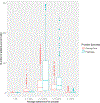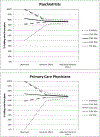Does Patient Adherence to Antidepressant Medication Actually Vary Between Physicians?
- PMID: 29068611
- PMCID: PMC7518124
- DOI: 10.4088/JCP.16m11324
Does Patient Adherence to Antidepressant Medication Actually Vary Between Physicians?
Abstract
Objective: Previous research and improvement efforts have presumed that patients' nonadherence to antidepressant medication reflects physicians' quality of care. We used population-based health records to examine whether adherence to antidepressant medication actually varies between prescribing physicians.
Methods: Electronic health records and insurance claims data from 5 integrated health systems in Washington, Idaho, Minnesota, Colorado, Hawaii, and California were used to identify 150,318 adults starting new episodes of antidepressant treatment for depression between January 1, 2010, and December 31, 2012. Early adherence was defined as any refill or dispensing of antidepressant medication in the 180 days following an initial antidepressant prescription. Patient-level demographic and clinical characteristics potentially associated with adherence were identified from health system records.
Results: Average probability of early adherence was 82% for psychiatrists and 74% for primary care physicians. Among individual physicians, the range of raw or unadjusted early adherence rates (5th to 95th percentiles) was from 33% to 100% for psychiatrists and from 0% to 100% for primary care physicians. After accounting for sampling variation and case mix differences, the range of adjusted early adherence rates (5th to 95th percentiles) was from 72% to 78% for psychiatrists and from 64% to 69% for primary care physicians.
Conclusions: After accounting for sampling variation and case mix differences, early adherence to antidepressant medication varies minimally among prescribing physicians. Early discontinuation of antidepressant treatment is not an appropriate measure of individual physician performance, and efforts to improve adherence should emphasize system-level interventions rather than the performance of individual physicians.
© Copyright 2018 Physicians Postgraduate Press, Inc.
Figures


Similar articles
-
Physicians' decisions to prescribe antidepressant therapy in older patients with depression in a US managed care plan.Drugs Aging. 2011 Jan 1;28(1):51-62. doi: 10.2165/11539900-000000000-00000. Drugs Aging. 2011. PMID: 21174487
-
Antidepressant prescriptions and adherence in primary care in India: Insights from a cluster randomized control trial.PLoS One. 2021 Mar 19;16(3):e0248641. doi: 10.1371/journal.pone.0248641. eCollection 2021. PLoS One. 2021. PMID: 33739982 Free PMC article. Clinical Trial.
-
Treatment process and outcomes for managed care patients receiving new antidepressant prescriptions from psychiatrists and primary care physicians.Arch Gen Psychiatry. 2001 Apr;58(4):395-401. doi: 10.1001/archpsyc.58.4.395. Arch Gen Psychiatry. 2001. PMID: 11296101
-
Why isn't bupropion the most frequently prescribed antidepressant?J Clin Psychiatry. 2005 May;66(5):603-10. doi: 10.4088/jcp.v66n0510. J Clin Psychiatry. 2005. PMID: 15889947 Review.
-
Antidepressant side effects and physician prescribing patterns.Ann Clin Psychiatry. 1993 Mar;5(1):7-11. doi: 10.3109/10401239309148918. Ann Clin Psychiatry. 1993. PMID: 8348199 Review.
Cited by
-
Effectiveness of interventions to improve medication adherence in adults with depressive disorders: a meta-analysis.BMC Psychiatry. 2022 Jul 20;22(1):487. doi: 10.1186/s12888-022-04120-w. BMC Psychiatry. 2022. PMID: 35858887 Free PMC article.
-
Effectiveness and cost-effectiveness of a multicomponent intervention to improve medication adherence in people with depressive disorders - MAPDep: a study protocol for a cluster randomized controlled trial.Patient Prefer Adherence. 2019 Feb 22;13:309-319. doi: 10.2147/PPA.S172963. eCollection 2019. Patient Prefer Adherence. 2019. PMID: 30863020 Free PMC article.
-
How to improve adherence to antidepressant treatments in patients with major depression: a psychoeducational consensus checklist.Ann Gen Psychiatry. 2020 Oct 12;19:61. doi: 10.1186/s12991-020-00306-2. eCollection 2020. Ann Gen Psychiatry. 2020. PMID: 33062034 Free PMC article. Review.
-
Identifying temporal patterns of adherence to antidepressants, bisphosphonates and statins, and associated patient factors.SSM Popul Health. 2021 Nov 19;17:100973. doi: 10.1016/j.ssmph.2021.100973. eCollection 2022 Mar. SSM Popul Health. 2021. PMID: 35106359 Free PMC article.
References
-
- Lin EH, Von Korff M, Katon W, et al. The role of the primary care physician in patients’ adherence to antidepressant therapy. Med Care. 1995;33(1):67–74. - PubMed
-
- Simon G, VonKorff M, Wagner E, Barlow W. Patterns of antidepressant use in community practice. Gen Hosp Psychiatry. 1993;15:399–408. - PubMed
-
- Coltin K, Beck A. The HEDIS Antidepressant Measure. Behavioral Healthcare Tomorrow. 1999(June):40–47. - PubMed
Publication types
MeSH terms
Substances
Grants and funding
LinkOut - more resources
Full Text Sources
Other Literature Sources
Medical

